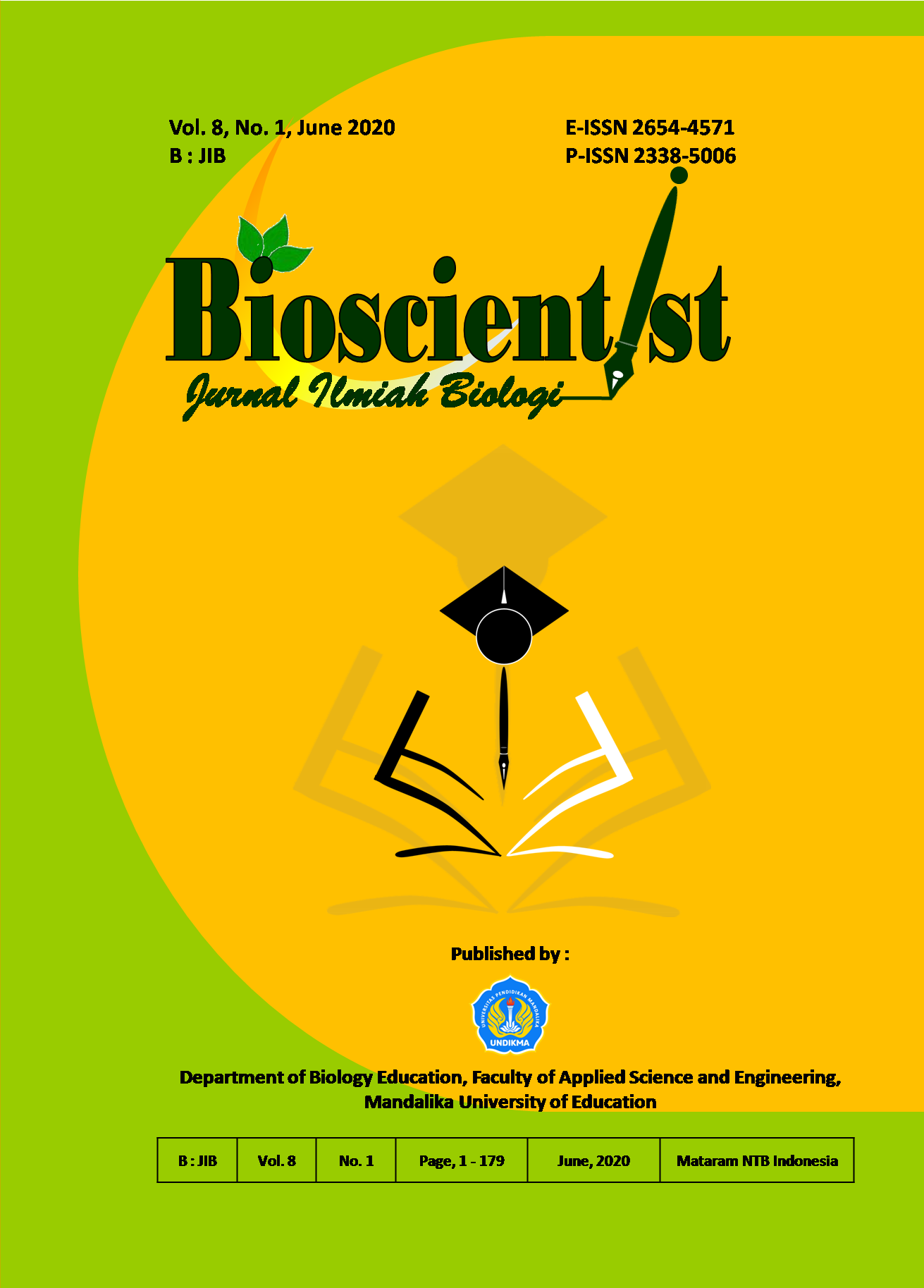INVENTARISASI SERANGGA TANAH DI TAMAN WISATA ALAM GUNUNG TUNAK KABUPATEN LOMBOK TENGAH
DOI:
https://doi.org/10.33394/bioscientist.v8i1.2560Keywords:
Inventarisation, Soil Insects.Abstract
Gunung Tunak Nature Tourism Park is a nature conservation area which is mainly used for tourism and nature recreation. Gunung Tunak Nature Tourism Park is one of 17 conservation areas managed by the Natural Resources Conservation Center (BKSDA), located in Mertak Village, Pujut District, Central Lombok Regency. Geographically located between 08º53'30.08º57'30 South Latitude, and 116º24'00†East Longitude. The purpose of this study was to determine the types of soil insects found in the Gunung Tunak Nature Park. This type of research is exploratory descriptive. The sampling method uses pitfall traps. Sampling locations include the park area in front of the butterfly breeding, and in front of the camping ground as posts 1 and 2. Sampling was carried out in the morning (07.00-09.30 WITA), and in the afternoon (16.00-17.30 WITA) with 3 repetitions. Soil insect samples obtained were identified at the level of the order and family at the Biology Laboratory, Mandalika University of Education. The results showed that 6 soil orders were found, namely: Orthoptera, Hymenoptera, Hemiptera, Diptera, Coleoptera, and Scorviones. The highest group of individuals found was the Hymenoptera Order with 93 individuals.References
Basna, M., Koneri, R., & Papu, A. (2017). Distribusi dan Diversitas Serangga Tanah di Taman Hutan Raya Gunung Tumpa Sulawesi Utara. Jurnal MIPA, 6(1), 36-42.
Nurhayati, Fahri, & Annawaty. (2017). Keanekaragaman Makrofauna Tanah pada Lubang Resapan Biopori yang Diisi Media Limbah Kulit Buah Kakao (Theobroma cacao L.). Jurnal Biocelebes, 11(1), 30-39.
Permana, R. S. (2015). Keanekaragaman Serangga Tanah di Cagar Alam Manggis Gadungan dan Perkebunan Kopi Mangli Kecamatan Puncu Kabupaten Kediri. Retrieved April 10, 2020, from http://www.etheses.uin-malang.ac.id/.
Rezatinur, W., Ilma, N., Meryanti, L., & Rosita. (2016). Populasi Serangga Permukaan Tanah Diurnal pada Biotop Terdedah dan Ternaung di Gampong Rinon Pulo Breuh Kecamatan Pulo Aceh Kabupaten Aceh Besar. Prosiding Seminar Nasional Biotik (pp. 154-157). Banda Aceh, Indonesia: Universitas Islam Negeri Ar-Raniry.
Sari, M. (2014). Identifikasi Serangga Dekomposer di Permukaan Tanah Hutan Tropis Daratan Rendah : Studi Kasus di Arboretum dan Komplek Kampus Universitas Lancang Kuning dengan Luas 9,2 Ha. Bio Lectura : Jurnal Pendidikan Biologi, 2(2), 140-149.
Subyanto, & Sulthoni, A. (2012). Kunci Determinasi Serangga. Yogyakarta: Kanisius.
Vincent, V., & Hadrien, L. (2013). Standardized Sampling Protocol for Spider Community Assessement in The Neotropical Rainforest. Journal of Entomology and Zoology Studies, 1, 18-34.
Wahyuni, T. E. (2016). Panduan Lapangan Kupu-kupu di Taman Wisata Alam Gunung Tunak. Lombok: Balai Konservasi Sumber Daya Alam Nusa Tenggara Barat.
Yuswana, A., Pakki, T., & Mariadi. (2018). Keanekaragaman Coleoptera dan Araneida Permukaan Tanah pada Berbagai Kondisi Sanitasi Kebun Kakao Rakyat di Kabupaten Kolaka Timur. Jurnal Biowallacea, 5(2), 803-812.
Zulkarnain, Arifin, A., & Riyanto. (2018). Inventarisasi Serangga Tanah di Lahan Bekas Kebakaran Desa Tanjung Batu Kecamatan Tanjung Batu Kabupaten Ogan Ilir dan Sumbangannnya pada Pembelajaran Biologi. Jurnal Pembelajaran Biologi, 5(1), 1-10.













